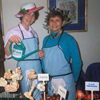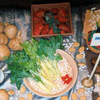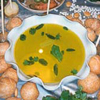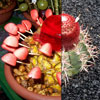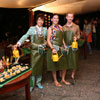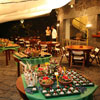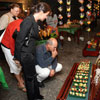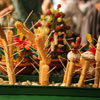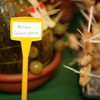A Temperate Menu (An Edible Garden), 1994, 1996, 1997, 1999, 2000 and 2007
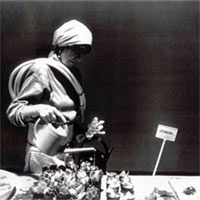 |
1st version
Centre for Performance Research, Cardiff, Wales (UK), 1994
This work was first performed for the Centre for Performance Research, Cardiff, in Wales in 1994 as part of the conference/festival Points of Contact #5: Performance, Food and Cookery. It consisted of a poetic sensorial simulation of a conventional greenhouse in which everything was edible. That is to say, a nursery converted into a gastronomic space. It took the form of an installation of a scenic nature.
Dressed for the garden in her scarf, apron and boots and wielding all manner of gardening tools, including a wheelbarrow, Alicia led the participants to the greenhouse. Exuberant tables were laden with edible imitations of all manner of exotic botanical specimen in various stages of growth, creating a game in which the products appeared real without being so.
In choosing the ingredients, the aesthetic criteria and the formal presentation of this edible nursery, both rules of classic vegetarianism and those of facile realism were avoided. The installation proposed, rather, a substitution in search of poetic irony by which that which is most similar to nature is made artificial whilst that which is most artificial is made more natural. Thus there were cacti of pickles, olives and caper berries, rice served as soil to be fertilised with consommé and a rock garden consisting of a variety of sweets and Spanish pastries made with olive oil.
A greenhouse is in itself already a form of nature made artificial, domesticated in a controlled indoor environment. It's a perfect intermediary space to stage a confusion of farm and kitchen. It was also a setting that responded to the location and time of the performance. Where better to harvest your lunch during winter in Wales but in a greenhouse? Alicia offered the participants/performers a little spring in the middle of winter.
She led lead them into a delicious whirlpool of edible intentions, in which participation was essential for the consummation of the project. Participants became gardeners, for if they were to enjoy the edible plants and flowers, they had to water and harvest the different botanical varieties represented. To this end they were provided with all the necessary gardening tools (a miniature rake, how and trowel) and watering cans filled with delicious fertilizing substances.
The work's strong narrative content made it highly theatrical, subtly involving everyone in the performance. This dynamism awakened the imagination to gradually discover the meaning, the idea within the symbol. Barbara Kirshenblatt-Gimblett describes her experience as a participant:
The eating was a form of harvesting. The mouth was a harvesting machine. To convey the metaphor even further, we used our hands and the gardening tools, but when we took things to our mouths, what was the machine into which we were putting them? Was it a threshing machine? Was it a mill? The body was a form of machine. It was very unnatural to become a grinding machine.
-Barbara Kirshenblatt-Gimblett, 'Alicia Rios, tailor of the body's interior: an interview' in The Drama Review 41(2), 1997, pp. 90-110, p. 107.
Press:
'By general consent of the participants, the most interesting and intellectually rigorous performance was a buffet mounted by Alicia Rios of Madrid...'
-Paul Levy, The Wall Street Journal, Europe, 21.1.94
'.the spectacle of Nature imitating Nature produces a certain mental disorientation; like the play within the play, the image within the image, it deliberately teases the brain, plays games with concepts of reality and distorts them. The delicious irony of it all was that, as we ate our lunch in the imaginary greenhouse.we were all unconsciously "performing"- under Alicia's direction. We were pawns in a semiotic game of signifiers chasing significance, where things were not what they were but what they represented and where the representations were the reality. In a world of make-believe, we were not even aware that we had been made to believe.'
-Barbara Santich, The Sydney Review, April 1994
'A Temperate Menu... makes the distinction between food event and theatre event moot, so completely do the two merge. Indeed, A Temperate Menu... was an opera offered to the senses.'
-Barbara Kirschenblatt-Gimblett, Performance Research, 4(1), 1999
2nd version
Tecla Sala, L'Hospitalet de Llobregat, Barcelona, 1996
The second staging of A Temperate Menu was in Barcelona for the inauguration of the art gallery Tecla Sala. The food was produced in coordination with the restaurateur and hospitality entrepreneur Rosa Esteva-Grewe.
3rd version
The Edible Olive Grove, for ASOLIVA-ICEX, Madrid, 1997
4th version
DAS ARTS (De Amsterdamse School, Advanced Research in Theatre and Dance Studies) Amsterdam, Holland, 1999
The work was later staged at DAS ARTS as part of the food conference/festival What's Cooking? Still Life, Turbulent Recipes. For this version of A Temperate Menu (An Edible Garden) Alicia had the collaboration and performance skills of 12 students of DAS ARTS and as a result the poetic side of the event was intensified. Due to their contribution and the artistic intention with which all the food was prepared, the event reached its highest degree of sophistication and complexity. The food display was even more colourful, with amazing and realistic landscapes. In addition they had the use of an actual greenhouse, making the effort of distinguishing between the real and unreal harder and the experience more satisfying.
Various additions were also made which, along with a new layout, created a more modern greenhouse complex. At the entrance were two students in special bio security suits performing security checks that included identity verification and germ sterilization. Inside, apart from the magnificent display of seedlings and plants, there was a laboratory with colourful, drinkable fertilizer probes and a (walnut) brain cloning process installation. During the event, marzipan rocks were continuously being made and candy floss handed to the visitors, who served themselves drinks from an automatic watering system.
All these different activities created the impression of being in a modern greenhouse. But of course it was all theatre and even the food was playing a part, trying to convince the participants they were what they seemed.
The poetic and comic experience begins when discovering what lies beneath all the apparent seriousness of the event: illusion.
5th version
Centre for Performance Research, Aberystwyth, Wales (UK), 2000
6th version
The Edible Cactus Nursery, Lanzarote, 2007
As part of ArteLanzarote 2007, organised by MIAC (Museo Internacional de Arte Contemporáneo, Arrecife), Ali&Cia created the Edible Cactus Nursery in the famous Cactus Garden designed by César Manrique in Guatiza. They were assisted in the design and creation of the cacti by the cooking workshop lead by Gonzalo Tavio Morales at the Comunidad Terapéutica of Zonzamas, a rehabilitation facility for people overcoming substance abuse.
The nursery seemed straightforward enough at first, featuring a large variety of cacti in pots classified according to botanical criteria. But, to their surprise, those present were invited to dig in and feast on the flora. Everything turned out to be deliciously edible. The key to the surprise was the careful reinterpretation of the natural environment according to its sensory qualities, offering an innovative means of assimilation. Collectively, Ali&Cia and the team from Zonzamas had drawn on traditional local ingredients and dishes along with those of recent arrival and, thanks to the magic of the naturalistic mise en scène, all those who attended were transformed into gardeners and cactophagi.
|
